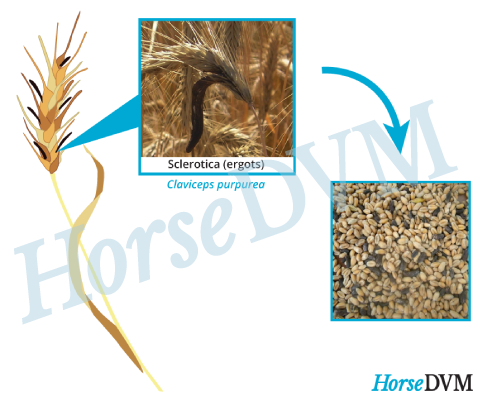Ergotism is a worldwide disease caused by ingestion of sclerotia (ergots) produced by the genera
Claviceps (
C. africana, C. sorghi, C. gigantean or
C. purpurea). Ergot sclerotias are hard, blackish-purple, small elongated fungal bodies which are about the same size as the grain. Ergots develop in place of the grain or seed within the flowerheads. When crops are harvested, ergots become mixed in with the rest of the grain. The problem with ergots are that they contain varying amounts of ergot alkaloids, which are one of six major classes of mycotoxins that are frequently found in cereal grains. Ergot alkaloids are toxic to all animals and humans if sufficient amounts are ingested. Most countries have banned the use of ergots in foods for human consumption, however it is used in livestock feeds. Ergot alkaloids are also produced by endophyte-contamined grasses (predominately tall fescue) containing the fungus
Neotyphodium coenophialum.
Ingestion of the ergots from consuming contaminated grain, hay, straw, or grasses causes ergotism. Humans and all species of animals are susceptible to poisoning, however livestock are most commonly affected due to the processing methods of feedstuff that are incorporated into their feed.
There are four forms of ergotism which can occur in cows, these include: gangrenous or cutaneous, hyperthermic, reproductive, and convulsive.
- Gangrenous or cutaneous: Associated with long-term ingestion of ergot-contaminated feedstuff. Results in the restriction of blood flow to parts of the body, causing tissue death, sloughing and foul odor from rotting flesh.
- Hyperthermic: Affects the temperature regulation of the body. Affected cattle are unable to cool themselves during high temperatures. It is associated with long-term ingestion of ergots.
- Reproductive: Results in reproductive failure, abortion, poor lactation and stillborn offspring. Sometimes offspring are born without any suckling reflex.
- Convulsive: The result of acute ingestion of large amounts of ergots in a short period of time. It is the rarest form, and causes hyperexcitability, bizarre behavior, convulsions and death.
 Attention! This is a potentially life-threatening condition for your Cow. Time is of the essence, contact your veterinarian immediately.
Attention! This is a potentially life-threatening condition for your Cow. Time is of the essence, contact your veterinarian immediately.